Pachamama Hygge Sofa Socks: A Handmade Review
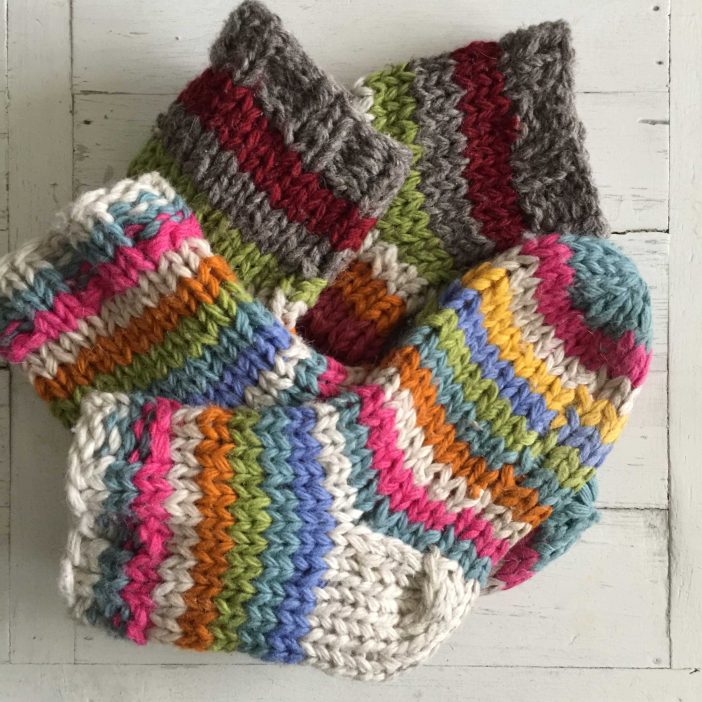
In the V&A Museum in London, there's a pair of socks from ancient Egypt.
They're ankle socks. Split toe, meant for sandals. Made from bright red wool sometime between 250 and 420 AD. Which means they're roughly 1,600 years old.
Here's what gets me: they look barely worn. Like someone in fourth-century Egypt finished making them, thought mmm, let's go for red, wore them maybe once or twice, and then... they survived. Through the fall of the Roman Empire. Through the Byzantine period. Through the Islamic Golden Age. Through the Crusades. Through everything.
Most of our socks don't survive sixteen weeks.
We barely think about them at all. They're the punchline of boring Christmas presents. They exist in that weird limbo of necessary but unloved objects - something you fiddle with to get your shoes on. The singular ones are even worse. They hang around in your drawer, perpetually hopeful, while you keep digging for a complete pair. You hold onto them because maybe, maybe, the other one will turn up.
It never does.
But then you're home on a cold afternoon. Coffee in hand. Feet tucked up on a comfortable sofa. And you're wearing hand-knitted wool socks that someone in Nepal made, working around their harvest schedule, and suddenly that ancient Egyptian choosing red makes complete sense.
Because some objects - the ones we actually feel - they transcend their category entirely.
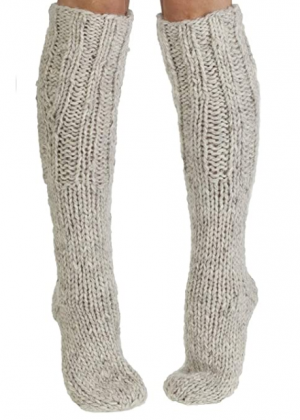
The Danes have a word for this feeling: hygge. Pronounced "heu-gah." It's everywhere now, stamped on candles and throw pillows and lifestyle blog posts. But the feeling itself is older than the trend. Older than the word, even. It's that sense of contentment and warmth that comes from being exactly where you are, with exactly what you need, and nothing more.
It's what those red socks represented 1,600 years ago. It's what good socks still represent now.
What Makes Pachamama Socks Different
Here's the thing about mass-produced socks: they're made to be adequate. Functional. The kind of thing you buy in a six-pack at Target without thinking twice.
Pachamama socks operate in a different universe entirely.
They're made by hand in Nepal. By actual people. Who knit them between planting and harvest seasons, working around the rhythms of agricultural life that haven't changed much in centuries. When you're wearing them, you're participating in an economy that predates Amazon Prime by... well, by about all of human history.
The company name itself - Pachamama - comes from Quechua, meaning "Earth Mother." It's not branding theater. The company pays home-workers in Nepal above-average wages, either in advance or by supplying raw materials upfront. No debt. No exploitation. Year-round orders despite seasonal demand, providing steady income throughout the year.
And crucially: no children involved in production.
So yes, these are feel-good socks in the most literal sense possible. But that's not the reason people keep wearing them.
People keep wearing them because they're 100% pure sheep wool, handcrafted using traditional knitting methods that create a thickness and warmth that machine production can't replicate. Each pair is slightly unique - the natural variation that comes from human hands working with natural materials.
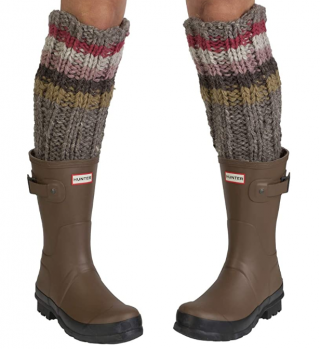
They're designed as sofa socks. Bed socks. The kind of thing people pull on when the temperature drops and frost starts forming on the window. But they're also practical enough to wear as wellie socks, durable enough to actually use rather than preserve. Unlike typical furniture protection plans, these don't require special care or worry - they're built to be used.
The question isn't whether someone needs hand-knitted wool socks from Nepal. The question is whether they want objects in their home that carry their history with them, that were made by someone who knows how to make them properly, and that will outlast the cheap alternatives by years.
The Women's Striped Grey Multicolored Version
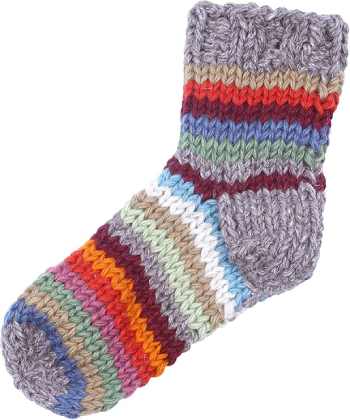
The women's version comes in a grey base with earthy multicolored stripes running through it. UK sizes 4-7, which translates to US women's 6-9.
The stripes aren't graphic design. They're the result of someone deciding, in real time, to switch colors. Sometimes the transitions are clean. Sometimes they're not. That's what handmade actually means - you can see the decisions.
The wool is thick enough that these work as standalone socks or layered over regular socks in serious cold. They're roomy by design, which sounds like a polite way of saying "oversized" but actually means they fit over other layers without cutting off circulation.
For bed socks, this works. Feet stay warm without feeling compressed. For sofa wear, it means feet can tuck up underneath without the socks sliding off or bunching uncomfortably.
The length hits mid-calf, providing coverage without the weird knee-sock thing that makes people feel like they're dressed for a Victorian novel.
View the women's grey striped socks on Amazon
The Men's Charcoal Broad-Stripe Version
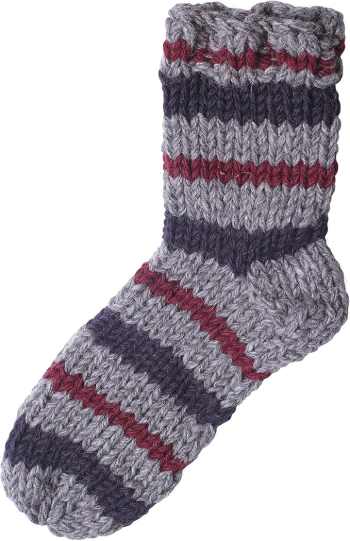
The men's version follows the same construction philosophy but shifts the aesthetic. Charcoal and claret on grey - what the product description calls "masculine variegated stripe," which is marketing speak for "we made it look less cheerful."
It works. These look like something people actually wear rather than something that arrived in a gift basket with lavender soap.
UK sizes 7-11 (US men's 8-12), same chunky construction, same traditional knitting methods. The broader stripe pattern means the color transitions are more deliberate, creating clear bands rather than the more organic progression of the women's version.
Same warmth. Same fair-trade production. Same durability. Just calibrated for people who want their socks to look like socks rather than a statement about artisanal craft.
Which, to be clear, they still are. They just don't announce it quite so loudly.
View the men's charcoal striped socks on Amazon
The Hygge Factor
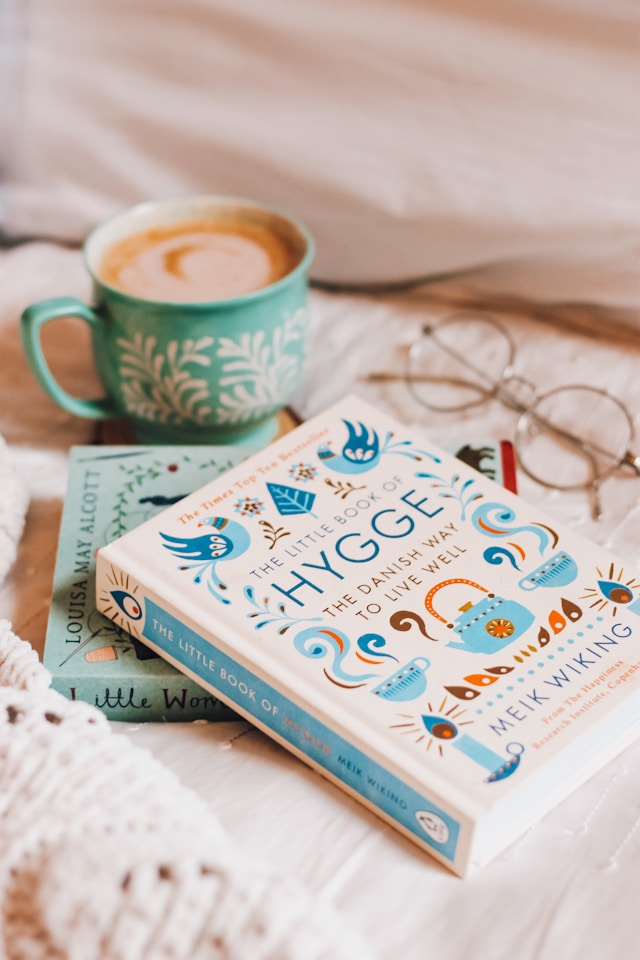
There's a reason the Danes invented a word for this feeling and then the rest of the world immediately needed it.
Because hygge isn't about candles and blankets and Instagram-ready lifestyle aesthetics. It's about the actual physical sensation of being warm and comfortable when it's cold outside. Of having exactly what you need, right now, without excess or performance.
It's the difference between looking cozy and being cozy.
Pachamama socks deliver on the actual thing, not the photograph of the thing. They're what people wear when no one's coming over. When they're reading or working from home or pursuing creative hobbies or recovering from exercise or just existing on a cold afternoon with coffee and time to kill.
They're roomy enough to wear over regular socks. Thick enough to function as slippers. Durable enough to wear outside if someone needs to dash to the car or check the mail. The 100% wool construction means they regulate temperature naturally - warm when warmth is needed, breathable enough not to overheat.
And unlike slippers, feet can tuck up on the sofa without that feeling of wearing shoes indoors. Which is the entire point of sofa socks in the first place. The same principle applies to other home furnishings - leather sofas feel different depending on the season, but wool socks work year-round.
Why These Work When Others Don't
Mass production optimizes for consistency and cost. Make ten thousand identical pairs of socks that will last one season and sell them for $8.
Traditional handcraft optimizes for durability and function. Make one pair of socks that will last for years and charge what it actually costs to make them properly.
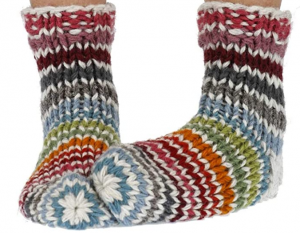
The Pachamama model splits the difference. The socks are handmade using traditional methods, which means they have the durability and warmth of proper wool construction. But the scale of production - year-round orders supporting multiple home-workers - means the price stays accessible rather than boutique.
This isn't artisanal theater. It's someone in Nepal having a steady income and someone else having socks that actually work.
The fair-trade certification isn't decoration. It means the supply chain is transparent, the wages are documented, and the working conditions are monitored. Which matters when wearing something that someone else made with their hands.
What Coffee and Socks Have in Common
Christmas morning. Coffee, mince pies, and warm hand-knitted socks. That's the hygge ideal in three objects.
But it's not just Christmas. Any cold morning works. Any afternoon when the temperature drops. Any evening when comfort matters more than performance.
The socks are part of a larger ecosystem of objects that make being at home actually pleasant. Like good coffee or a comfortable chair or proper lighting. Things that get used constantly but barely noticed until they're gone.
Which brings us back to those Egyptian socks in the V&A. Someone made them 1,600 years ago. Someone chose red. Someone wore them, maybe once, maybe a dozen times. And they survived.
Not because they were precious. But because they were good.
Pachamama makes good socks. Handmade in Nepal by people who know how to make them. Fair wages, traditional methods, 100% wool. They come in different styles and patterns, all designed to keep feet warm when it's cold outside.
That's it. That's the whole story.
No revolutionary technology. No disruptive innovation. Just socks that work, made by people who are paid fairly to make them.
View the full range of Pachamama socks here. The hats and gloves are there too, made with the same attention to actual craft rather than the performance of craft.
Those ancient Egyptians knew what they were doing when they chose red. Sometimes the best things are also the simplest things. Warm feet. Fair wages. Socks that last.
That's hygge. That's what survives.